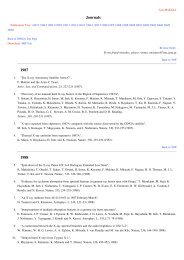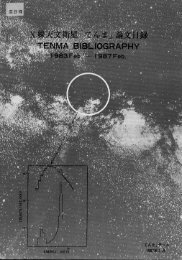Accordingly, we hereafter concentrate on the four XRT-I modules (XRT-I0 through I3) whichfocus incident X-<strong>ray</strong>s onto the XIS detectors.3.1. Optical Axis<strong>The</strong> maximum transmission of each telescope module is achieved when a target star isobserved along the optical axis. <strong>The</strong> optical axes of the four XRT-I modules are, however,expected to scatter within an angular range of ∼1 ′ . Accordingly, we need to define the axisto be used for real observations that provides a reasonable compromise among the four opticalaxes. We hereafter refer to this axis as the observation axis.In order to determine this observation axis, we have first searched for the optical axis ofeach XRT-I module by observing the Crab Nebula at various off-axis angles. <strong>The</strong> observationsof the Crab Nebula were carried out in the following three groups. Hereafter all the off-axisangles are expressed in the detector coordinate system (Det-X,Det-Y) (Ishisaki et al. <strong>2006</strong>).1. 2005 Aug. 22 03:30UT – 15:33UT: a short observation near the center of the detectors,which is defined as the origin (0 ′ ,0 ′ ) of the (Det-X,Det-Y) scheme, until 06:00UT followedby the four 10 ′ -off observations at (Det-X,Det-Y) = (±10 ′ ,0 ′ ) and (0 ′ ,±10 ′ ).2. 2005 Aug. 24 23:58UT – Aug. 27 07:30UT: a series of the off-axis observations at(Det-X,Det-Y) = (±3. ′ 5,0 ′ ), (0 ′ ,±3. ′ 5), (±7. ′ 0,0 ′ ), (0 ′ ,±7. ′ 0), (±20,0 ′ ), (0 ′ ,±20 ′ ), (+50 ′ ,0 ′ )and (+120 ′ ,0 ′ ).3. 2005 Sep. 15 01:00UT – Sep. 16 08:50UT: pointings at the XIS default position(Det-X,Det-Y) = (0 ′ ,0 ′ ) and the HXD default position (Det-X,Det-Y) = (−3. ′ 5,0 ′ ) as wellas the remaining three 50 ′ off pointings at (Det-X,Det-Y) = (−50 ′ ,0 ′ ) and (0 ′ ,±50 ′ ).Note that the field of view of the XIS detector is a square with 17. ′ 8 on a side. Thus only thedata taken at the origin, at ±3. ′ 5-off and at ±7. ′ 0-off are available for determining the opticalaxes.By fitting a model of a Gaussian plus a constant to the count rate as a function of theoff-axis angle, we determined the optical axis of each XRT-I module. <strong>The</strong> results are given inFig. 8. Since the optical axes moderately scatter around the origin, we have decided to adopt itas the observation axis for XIS-oriented observations as the default. Hereafter we refer to thisaxis as the XIS-default orientation, or equivalently, the XIS-default position. <strong>The</strong> optical axisof XRT-I0 shows the largest deviation of ∼1. ′ 3 from the XIS-default position. Nevertheless, theefficiency of XRT-I0 at the XIS-default position is more than 97% even in the highest 8–10 keVband (see Fig. 11). <strong>The</strong> optical axis of the HXD PIN detector, on the other hand, deviates by∼5 ′ in the negative Det-X direction (Takahashi et al. <strong>2006</strong>; Kokubun et al. <strong>2006</strong>). Because ofthis, the observation efficiency of the HXD PIN at the XIS-default orientation is reduced to∼93% of the on-axis value. We thus provide another default pointing position, the HXD-defaultposition, for HXD-oriented observations, at (Det-X, Det-Y) = (−3. ′ 5, 0 ′ ). At the HXD-defaultposition, the efficiency of the HXD PIN is nearly 100%, whereas that of the XIS is ∼88% on12
Fig. 8. Locations of the optical axis of each XRT-I module in the focal plane determined from the observationsof the Crab Nebula in 2005 August–September. This figure implies that the image on each XISdetector becomes brightest when a target star is placed at the position of the corresponding cross. <strong>The</strong>dotted circles are drawn every 30 ′′ in radius from the XIS-default position (see the text).the average.3.2. Effective AreaIn-flight calibration of the effective area has been carried out with the version 0.7 processeddata (Mitsuda et al. <strong>2006</strong>) of the Crab Nebula both at the XIS/HXD-default positions.<strong>The</strong> observations were carried out in 2005 September 15–16 (§3.1). <strong>The</strong> data were taken inthe normal mode with the 0.1 s burst option in which the CCD is exposed during 0.1 s out ofthe full-frame read-out time of 8 s, in order to avoid event pile-up and telemetry saturation.<strong>The</strong> exposure time of 0.1 s is, however, comparable to the frame transfer time of 0.025 s. Asa matter of fact, the Crab image is elongated in the frame-transfer direction due to so-calledout-of-time events, as shown in Fig. 9. Accordingly, the background-integration regions with asize of 126 by 1024 pixels are taken at the left and right ends of the chip for the XIS-defaultposition, perpendicularly to the frame-transfer direction, as shown in the left panel of Fig. 9.For observations at the HXD-default observation, the image center is shifted from the XISdefaultposition in the direction perpendicular to the frame-transfer direction for XIS0 andXIS3. Hence we can adopt the same background-integration regions as those of the XIS-defaultposition for these two XIS modules. For XIS1 and XIS2, on the other hand, the image shiftoccurs in the frame-transfer direction, as shown in the right panel of Fig. 9. We thus take a13













